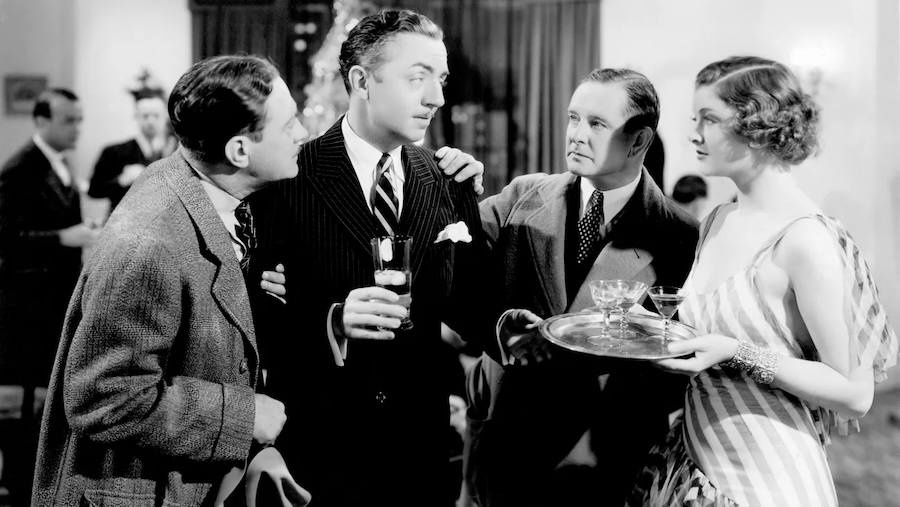
A LAUGH TOPS EVERY THRILLING MOMENT!

When William Powell arrived on his first day on the set of this film, he was going to shoot the scene where his character Nick Charles would be introduced to audiences. It takes place in a bar and director W.S. Van Dyke gave Powell a cocktail shaker and told him to go through the scene while the crew was getting everything ready. Powell did as he was told, goofing around a little bit and adding a few of his own lines.
When he was done, he was most likely startled to learn that Van Dyke had been shooting the whole thing and was ready for next scene. That’s how the director worked and everybody on set had better buckle up for a bumpy ride.
A retired detective in San Francisco
When Clyde Wynant (Edward Ellis) goes missing during a business trip, his daughter Dorothy (Maureen O’Sullivan) becomes worried; her father had promised to be home for her wedding. She goes to see Nick Charles (Powell), a retired detective who lives in San Francisco with his wife Nora (Myrna Loy) and their little terrier Asta. The Charleses are currently in New York to spend Christmas and Nick is initially not very interested in taking the case, but becomes drawn into it. When Clyde’s former secretary is found dead, the police believe that he murdered her and the hunt is on. However, Nick has his doubts…
Influenced by three couples
Dashiell Hammett allegedly based the bantering relationship between Nick and Nora on that between himself and Lillian Hellman. Screenwriters Albert Hackett and Frances Goodrich were married, so I’m sure they worked some of their own experiences into the adaptation. And on top of that, Powell and Loy got along very well on set. Van Dyke noticed how they bantered with each other off camera and worked that into the movie. These different layers of charisma between three different couples became the irresistible foundation for this movie and the thing that makes it such a great comedy – and turned it into a huge hit with audiences and critics, resulting in a Best Picture Oscar nomination.
William Powell and Myrna Loy are fabulously attractive as the hard-partying, urbane Charleses, supported by several other amusing cast members.
Powell and Loy weren’t natural choices; he was seen as perhaps too uptight to play Nick and she had become famous for playing exotic and dangerous women, which wasn’t really Nora. But somehow they clicked, looking relaxed on screen. They are fabulously attractive as the hard-partying, urbane Charleses, supported by several other amusing cast members; O’Sullivan (at the time more famous as Jane in Johnny Weissmuller’s Tarzan movies) doesn’t make much of an impression, but Edward Brophy is hilarious as a not particularly smart but tough guy.
Van Dyke moved very fast as he put this film together; it may not have created the best atmosphere on set (O’Sullivan later said that she didn’t like making the movie because the production was so rushed), but everything holds up remarkably well. The mystery is nothing special, and the identity of the killer seems random… but it has never mattered because we do enjoy so much the frantic pace, the witty dialogue and how well Van Dyke stages complex, crowded scenes like Nick and Nora’s Christmas party and the climactic dinner where Nick solves the mystery.
The sophisticated 1930s setting is another plus. The true breakout star of The Thin Man though is Skippy, the terrier who plays Asta. A true charmer, (although it did bite Loy one time) the dog became so famous after this movie that not only did its owners make a lot of money throughout Skippy’s career, but the name Asta stuck. Even when Skippy made non-Thin Man films like Bringing Up Baby (1938), the dog was credited as ”Asta”. Now, that’s fame.
The Thin Man 1934-U.S. 93 min. B/W. Directed by W.S. Van Dyke. Screenplay: Albert Hackett, Frances Goodrich. Novel: Dashiell Hammett. Cast: William Powell (Nick Charles), Myrna Loy (Nora Charles), Maureen O’Sullivan (Dorothy Wynant), Nat Pendleton, Minna Gombell, Cesar Romero.
Trivia: Followed by five sequels, starting with After the Thin Man (1936); later a TV series, The Thin Man (1957-1959).
Quote: “Waiter, will you serve the nuts? I mean, will you serve the guests the nuts?” (Loy during the climactic dinner scene)
Last word: “When [Loy and I] did a scene together, we forgot about technique, camera angles, and microphones. We weren’t acting. We were just two people in perfect harmony. Myrna, unlike some actresses who think only of themselves, has the happy faculty of being able to listen while the other fellow says his lines. She has the give and take of acting that brings out the best.” (Powell, TCM)
